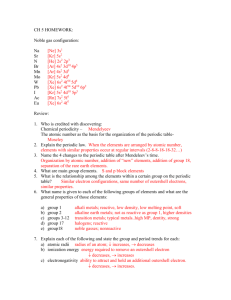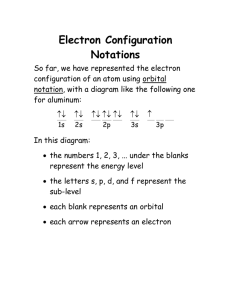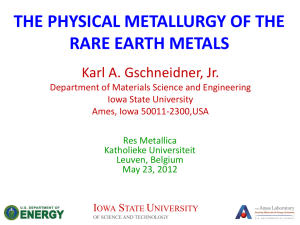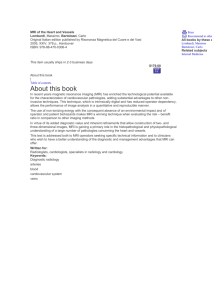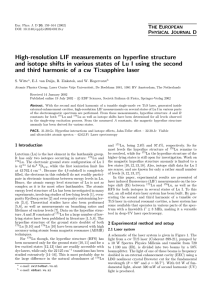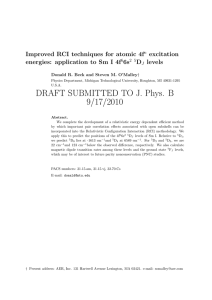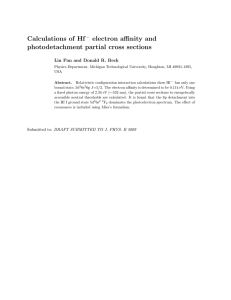F-block Elements - Bryn Mawr College
advertisement
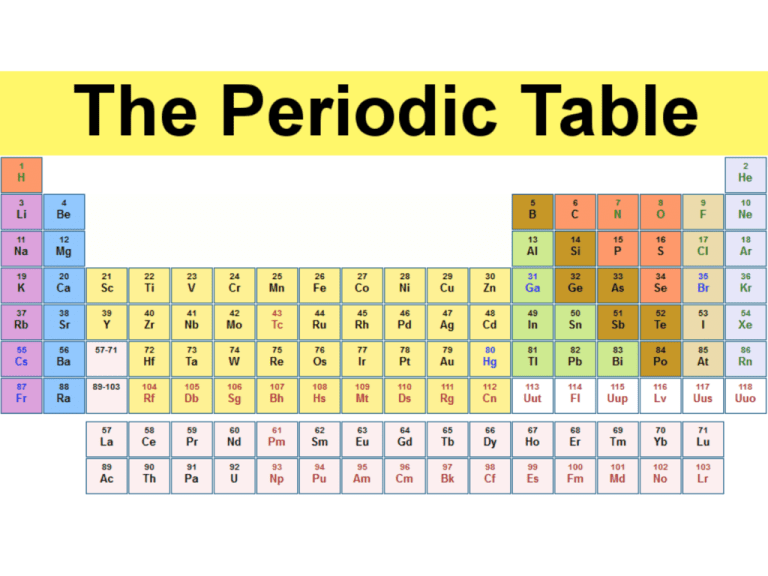
How do the electrons fill for Rare Earths? The shape of the seven 4f orbitals (cubic set). From left to right: (top row) 4fy3, 4fx3, 4fz3, (middle row) 4fx(z2-y2), 4fy(z2-x2), 4fz(x2-y2), and (bottom row) 4fxyz. For each, the copper zones are where the wave functions have negative values and the gold zones denote positive values. Rare Earth Concepts 1. Electron configurations— Lanthanides fill 4f orbitals; Actinides fill 5f orbitals F-orbitals are 7-fold degenerate. **More than one way to depict them!! General set 4fz3 4fxz2 4fyz2 4fy(3x2-y2) 4fx(x2-3y2) 4fxyz 4fz(x2-y2) Cubic set 4fx3, 4fy3, 4fz3 4fx(z2-y2), 4fy(z2-x2), 4fz(x2-y2), 4fxyz Lanthanides: 4f orbitals are buried, feel increasing nuclear charge Z Causes Lanthanide contraction no covalent bonding with 4f, ionic and hard ions mainly 3+ ions Actinides: 5f orbitals are somewhat shielded increasing amount of covalency more oxidation states available, because energies of the 5f, 6d, 7s and 7p are similar and can participate in covalent bonds oxidation states from 2+ to 7+ (U:3+ to 6+, Pu 3+ to 7+, Am:2+ to 6+ ) “Rare Earths” are not rare!! Difficult to separate: nearly same size Lanthanide Electron Configurations Symbol Idealized Observed Symbol Idealized Observed La Ce Pr Nd Pm Sm Eu Gd 5d16s2 4f15d16s2 4f25d16s2 4f35d16s2 4f45d16s2 4f55d16s2 4f65d16s2 4f75d16s2 5d16s2 4f15d16s2 4f3 6s2 4f4 6s2 4f5 6s2 4f6 6s2 4f7 6s2 4f75d16s2 Tb Dy Ho Er Tm Yb Lu 4f85d16s2 4f95d16s2 4f105d16s2 4f115d16s2 4f125d16s2 4f135d16s2 4f145d16s2 4f9 6s2 4f10 6s2 4f11 6s2 4f12 6s2 4f13 6s2 4f14 6s2 4f145d16s2 Ion La3+ Ce3+ Pr3+ Nd3+ Pm3+ Sm3+ Eu3+ Gd3+ Unpaired e0 1 2 3 4 5 6 7 Color Colorless Colorless Green Reddish Pink; yellow Yellow Pale Pink Colorless Ion Tb3+ Dy3+ Ho3+ Er3+ Tm3+ Yb3+ Lu3+ Unpaired eColor 6 Pale Pink 5 Yellow 4 Pink; yellow 3 Reddish 2 Green 1 Colorless 0 Colorless The diamagnetic ions are: La3+, Lu3+, Yb2+ and Ce4+. The rest are paramagnetic. Lanthanides share many similar characteristics, key ones include the following: Similarity in physical properties throughout the series Adoption mainly of the +3 oxidation state, and +2 or +4 for some A preference for more electronegative elements (such as O or F) binding Very small crystal-field effects Little dependence on ligands Ionic complexes undergo rapid ligand-exchange High coordination numbers (usually 8-9), tends to decrease C. N. across the series Like a supersized Na+ ??? [Ln(NO3)6]3- Lanthanides have strong fluorescence Visible emission (from left to right) of complexes with Tb(III), Eu(III), Dy(III) and Sm(III). NMR Paramagnetic Shift Reagents EuFOD :also called Eu(fod)3. Eu(OCC(CH3)3CHCOC3F7)3 Ground state electron configuration: [Xe] 4f7 6s2 Term Symbol: 8S7/2 how many unpaired e-? NMR Paramagnetic Shift Reagents: Eu vs Pr Using Eu(fod)3 oooh! Lovely!! With NO Shift rgt Hmmm, not so pretty Using Pr(fod)3 Huh? – signals shifted upfield with Pr MRI Contrast agents: same principles, applied to medicine • • • • • MRI Contrast Agents: observes differential magnetization of protons in different types of molecules that predominate in different tissues. The different magnetization signal intensities produce the contrast between tissues. The nuclear magnetization is produced by the pulse sequence applied, by the density of nuclear spins sub-fractions (water vs fat protons) and by the spin-lattice relaxation time T1 and phase relaxation time T2 in each nuclear spin sub-fraction. T1 and T2 depend on tissues type. MRI Contrast Agents interact with one sub-fraction type (usually that easily exchangeable protons, like water) to increase the T1 spin-lattice relaxation times. The most commonly used compounds for contrast enhancement are gadolinium-based. MRI contrast agents are used as oral or intravenous administration. Gadoteric acid Effect of contrast agent on images: Defect of the blood–brain barrier after stroke shown in MRI. T1-weighted images, left image without, right image with contrast medium administration. MRI Contrast agents: most bind H2O MRI scan of mouse injected with Gd-TREN-bis-(1-Me)3,2-HOPO-TAM-PEG. Thompson, M. K.; Misselwitz, B.; Tso, L. S.; Doble, D. M. J.; Schmitt-Willich, H.; Raymond, K. N. J. Med. Chem. 2005, 48, 3874-3877. New Contrast Agents: multi-armed octopi model Ken Raymond labs, Berkely Lanthanides in Organic Synthesis • Lanthanide metals are useful for reduction of functional groups and for carbon-carbon bond forming reactions • Eu, Sm, and Yb can form relatively stable 2+ states. Eu exists in water. • SmI2 is the most widely employed Ln(II) and is used for one electron reductive reactions • Trivalent lanthanides are hard Lewis acids with high oxophilicity and as such are employed in several highly selective reactions (Luche reduction, hetero-Diels-Alder) rare earth superconductors the first metal site in the molecule is always occupied by a rare earth atom. YPd2B2C LuNi2B2C YNi2B2C TmNi2B2C ErNi2B2C HoNi2B2C 23 K 16.6 K 15.5 K 11 K 10.5 K 7.5 K (ferromagnetic) Parent structure LaCuO3 (related to perovskite, CaTiO3) Rare earth doped material YBa2Cu3O7 : “1-2-3 type” superconductor The Meissner effect The Meissner effect in superconductors like this black ceramic yttrium based superconductor acts to exclude magnetic fields from the material. Since the electrical resistance is zero, supercurrents are generated in the material to exclude the magnetic fields from a magnet brought near it. The currents which cancel the external field produce magnetic poles which mirror the poles of the permanent magnet, repelling them to provide the lift to levitate the magnet. The levitation process is quite remarkable. Since the levitating currents in the superconductor meet no resistance, they can adjust almost instantly to maintain the levitation. The suspended magnet can be moved, put into oscillation, or even spun rapidly and the levitation currents will adjust to keep it in suspension.
